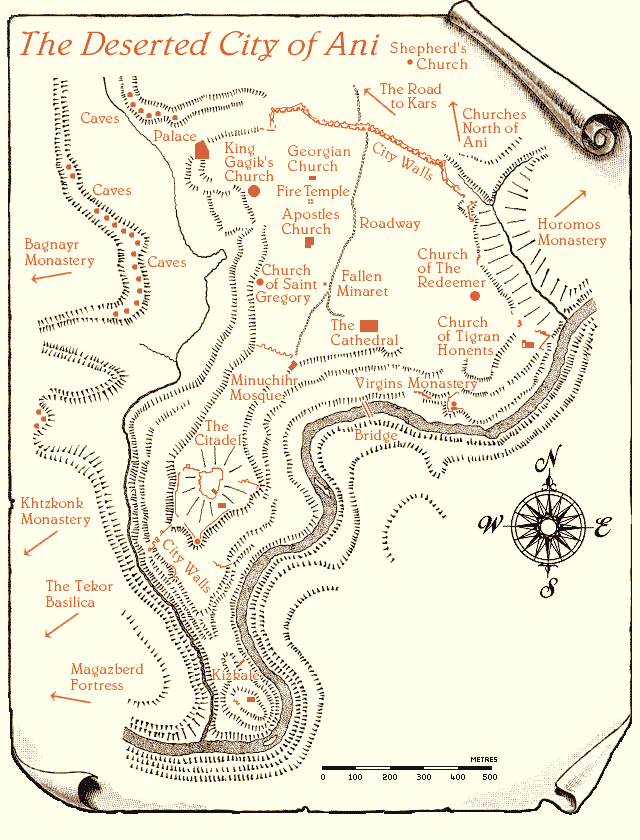Fact No. 17.
Ani was known as the city of a thousand and one churches.
The history of Armenia counts up to twelve capitals. The existence of so many seats of government attests to the instability of the Armenian state, and to a number of invasions and conquerors. But it is also a sign, each time, of renewed efforts to establish kingdoms, principalities, and, finally, republics.
Out of all of Armenia’s capitals, Ani stands out as one of the most celebrated in its time. The very last independent Armenian kingdom on traditional territory – ruled by the Bagratouni (Bagratid) dynasty – moved the court here in the year 971 AD. Construction works brought in a bigger population, and the city developed into a local trade hub, on the routes going both east and west, as well as north and south. The population in the next decades might have been between 100,000 and 200,000, rivalling Baghdad and Constantinople, while certainly surpassing London and Paris of that time.
The growth of Ani eventually gave it the moniker, “the city of a thousand and one churches”. One of the numerous churches, this one located outside the city walls, was known as the Church of the Shepherd, due to a tradition that a shepherd’s wife could not find peace and quiet for prayer amidst the crowds in all the other churches of the city. The architecture of Ani in general – and in particular, its famed cathedral – is noted today for its impact on the development of the Gothic architectural tradition, which spread throughout Europe in the centuries that followed.
Byzantine pressure and machinations finally caused Ani to relent in 1045 AD, bringing an end to the Bagratouni period of Armenian history. The Seljuk Turks successfully took over the city not too long afterwards, in 1064, followed by a decisive victory over the Byzantines in the Battle of Manzikert in 1071. Although, in subsequent centuries, the city maintained some importance under Kurdish, Georgian, and Mongol rule, Ani’s prosperity declined by the late 14th century. It continued to function as a town for a few hundred years more, losing all inhabitants by the 1750s or so.
Ani is in Turkey today, just across the Akhourian river that forms the border with Armenia. It is possible to view the ruins from Armenian territory. It is a site open to tourists, who benefit from the archaeological work and some preservation done there. Funds have been allocated in recent years, in fact, through foreign governments and non-profits, alongside co-operation with governmental bodies and NGOs in Turkey to work on the study and conservation of Ani. However, as with most Armenian cultural locations and artifacts in Turkey, there is often a lack of adequate care and sometimes open neglect. Certainly the absence of recognition of the importance of such places not only as part of the Armenian heritage, but also within the history of Turkey itself, remains dominant in official and non-official circles.
The 100 Years, 100 Facts Project recommends exploring the VirtualANI website for an in-depth look at the Bagratouni capital. An aerial view of Ani today can be seen through Google Earth.
References and Other Resources
1. VirtualANI
2. Simon Maghakyan. “Sexy Ani? Fashion at Sacred Armenian Ruins Raises Eyebrows”, Ararat, January 28, 2011
3. Stephen Kinzer. “A Hidden Empire in Turkey”, The New York Times, October 8, 2000
4. Alan Taylor. “The Ancient Ghost City of Ani”, The Atlantic, January 24, 2014
5. Ella Morton. “Ani, the Ancient Armenian Ghost Town”, Slate, March 19, 2014
6. World Monuments Fund. Ani Cathedral
7. Wikipedia: “Ani”
Image Caption
An engraving of Ani from 1885.
Attribution and Source
Originally from the British illustrated weekly, The Graphic
By Unknown. Uploaded by Ohannes Kurkdjian [Public domain], via Wikimedia Commons
Follow us on
Recent Facts
Fact No. 100
…and the Armenian people continue to remember and to...
Fact No. 99
…as minorities in Turkey are often limited in their expression…
Fact No. 98
Armenians continue to live in Turkey…
Fact No. 97
The world’s longest aerial tramway opened in Armenia in 2010


